| 1 | Zebra spitting cobra |
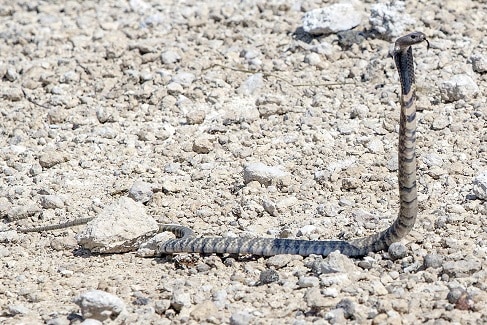
The zebra spitting cobra lives in Namibia and southern Angola. It measures 1.2-1.5 metres, and only became an official species in 2007. Zebra spitting cobras prefer parched, dry areas, never appearing in forests. You can tell it’s a cobra by its fast speed and thin body, plus its complete lack of fear of slithering through open spaces.
Down to the species level, there are no other cobras with the zebra-like black and white stripes. Naja nigricincta was originally a black-necked spitting cobra subspecies, but that snake has broad, sweeping black patches instead. Hence, Naja nigricincta was split off, and the main cobra it overlaps with is the cape cobra (which is non-spitting). This is a plainer olive colour.
With a love of parched, open spaces, Naja nigricinta is easier to observe from a distance, particularly if your trusty binoculars are handy. Zoom in, spot the stripes, and you’ll have officially narrowed down the 3900 snake species to just one. Be careful though: they can spit several metres and are extremely fast. If the spitting cobra seems to getting bigger and bigger through your binoculars, it may be time to run.
| 2 | Red diamond rattlesnake |
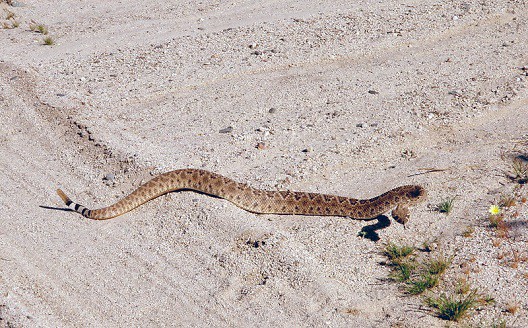
An extremely abundant rattlesnake in southern California. Red diamond rattlesnakes are particularly common in dry, scenic foothills, preferring medium to low elevations of up to 1500 metres. Mojave and west diamondback rattlers are also found nearby, but red diamonders are a no brainer. First is the red tone of their body, and second is the sharp contrast against a black-white tail. This tail occurs before the segmented rattles (which are beige); the tail alternates from black to white like a chessboard, before a sudden transition. This tail is even noticeable from a distance, as are the red tinges.
As with zebra spitting cobras, Crotalus ruber prefers open areas, making them easy to spot. A seasoned binocular pro could identify one from over a mile away, on a lower level of the hillside. Red diamond rattlesnakes don’t top the venom toxicity tables, but their venom is still dangerous. They’re highly proficient in haemorrhaging, weakening capillary walls, while destroying fibrinogen to ensure that bleeding continues unabated.
That said, no deaths have ever been confirmed. Unlike prairie rattlesnakes, red diamonders aren’t social, and you won’t find gangs of them prowling the southern Californian hills.
| 3 | Banded flying snake |
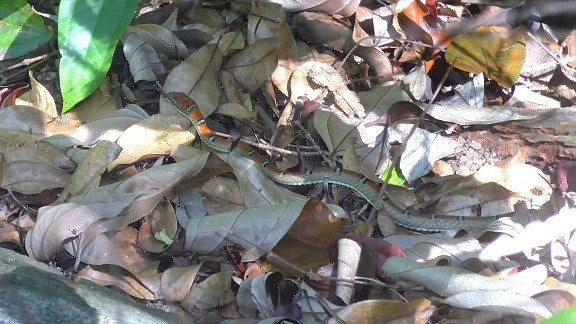
The tiny nation of Singapore hosts 67 snake species. Yet once armed with the basic facts, on the tip of your tongue, separating banded flying snakes from the pack is easy. It helps that Chrysopelea pelias can fly, or more accurately glide. They leap from trees, extend their ribs sideways to create an air pocket, and travel up to 100 metres in mid-air. But their complex colours are a dead giveaway.
Technically, the basic colour is a boring grey, but the first touch is snowy white encircling bands. Between these lie red splashes, like dabs of paint. There’s also more subtle white markings scattered around. Banded flying snakes are a memorable snake even when slithering on the ground. Other ID signs include a fast speed and 70cm length. Chrysopelea pelias coexists in Singapore with a cousin, the paradise flying snake. This is clearly differentiated by a lack of encircling bands, and a far greener colour.
Singapore is relatively popular with tourists, and the likes of Bukit Timah and Thomson Nature Reserve are not far from the main city. This might be the species to alert you to the horrifying reality that some snakes can fly.
| 4 | Black-headed python |

It’s surprising, but Australia still has several large serpents with barely an article worth of research to their name. The black-headed python (Aspidites melanocephalus) is one. It’s a burrowing python which effortlessly thrusts its way into soft sands, before vanishing completely as its tail drops out of sight.
There are few detailed diet studies, nor on interactions between males and females. Black-headed pythons live in the dry Queensland and Northern Territory outback, with rules and codes that suburban Sydney-ites can’t comprehend. What we do know is how to recognise them. There’s no way you could confuse Aspidites melanocephalus with a scrub python or olive python, and it’s all thanks to their signature black head. The black is all-consuming, enough that their eyes are a struggle to make out. In other Australian pythons, the head matches the body; olive for olive pythons, green for a green tree python.
The exact evolutionary reason for the black head remains unknown. However, it may be safety against bird predators. Black-headed pythons are nocturnal, and if they poke just their head out of their burrows at 11pm, it may help them to go unnoticed, to blend with the blackness. They can thus scan their surroundings for prey without being hunted.
| 5 | Golden-head garter snake |
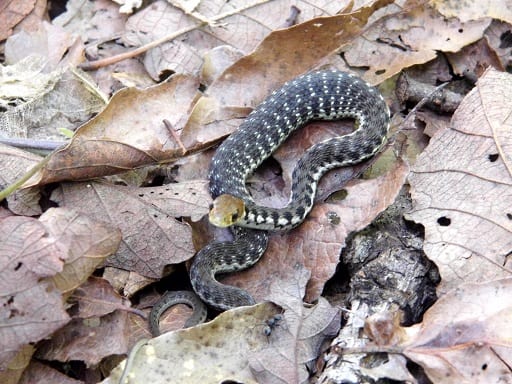
A harmless species measuring 50-60cm. Golden-headed garter snakes are a rare family member, and virtually nothing is known about them. They live in dry woodlands of southern Mexico, and they may be growing endangered as these narrow habitats are chopped down.
The clue is in the title: Thamnophis chrysocephalus has a gold head which easily separates them from nearby rattlesnakes, coral snakes or gopher snakes. This makes them simple to recognise within the Thamnophis family too. Lots of garter snakes are virtually indistinguishable. Even a herpetological mastermind struggles to spot the difference between Butler’s garter snake and the common garter snake, or the plains and the common garter. Terrestrial garter snakes are also tricky, but with this species you have a golden head every time.
It’s unlikely that you’ll ever come face to face with this gold-plated serpent. But if you do, you’ll have an instant ID sign, with which you can instantly recognise them. Learn the Latin name and you can impress your friends, convincing them that you’re a renaissance man.
| 6 | Mexican cantil |

Part of the same family as cottonmouths and copperheads. Mexican cantils (Agkistrodon bilineatus) live in southern and central Mexico, mainly in dry woodland, particularly dry thorny woodland. Vipers are abundant in Mexico, including over 20 rattlesnakes, but Mexican cantils look like no other. Their bodies are pitch black, including the head. The only patterns are thin slashes of white, like cracks in a door frame at midnight. The contrast is extremely vivid.
Mexican cantils are also very thick bodied. So are many rattlesnakes, but none in Mexico are so black. Arizona black rattlesnakes have the most similar patterns on Earth, with midnight black contrasting against starry white. However, they live over 1000 miles away, in towering Arizona mountain ranges.
Agkistrodon bilineatus is also unique within its family. Copperheads are orange with hourglasses, while cottonmouths are muddy brown. Mexican cantils are nocturnal, and their pitch black palette probably evolved to keep them hidden. They’re reputed as highly aggressive, and their venom is severely necrotic, shredding skin tissue and the muscles below.
| 7 | Jamaican boa |
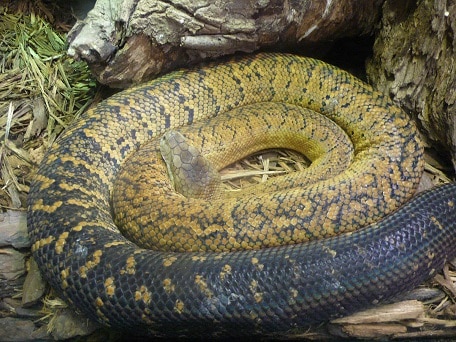
Earth has over 40 living boas, with the 18 metre titanoboa sadly extinct. Only one combines ornate gold-black in the majority of its populations, and that’s the Jamaican boa. This species is found only on Jamaican, in increasingly fragmented pockets, as deforestation spreads. One hotspot is Cockpit County, where rebels hid after rebelling against British rule in the 18th century. Cuba has its own boa, Puerto Rico has its own boa, but Jamaican boas are distinct from both.
The exact proportion of gold and black vary, but you won’t find a silver Jamaican boa, for example. If boa constrictors have a yellowish morph, they tend to be one plain colour, rather than ornate richness like with this snake.
Jamaican boas are easy to recognise on the international reptile market, and in their homeland, it’s even easier. There are no native serpents that resemble the Jamaican boa, in colour or size. Jamaican boas are the island’s largest snake, pushing to 2.5 metres, and with a maximum of 2.8 metres. This is an easy snake to keep in captivity, as they have a flexible diet. They eat rats and mice galore, but won’t say no to birds either.
| 8 | Green tree python |
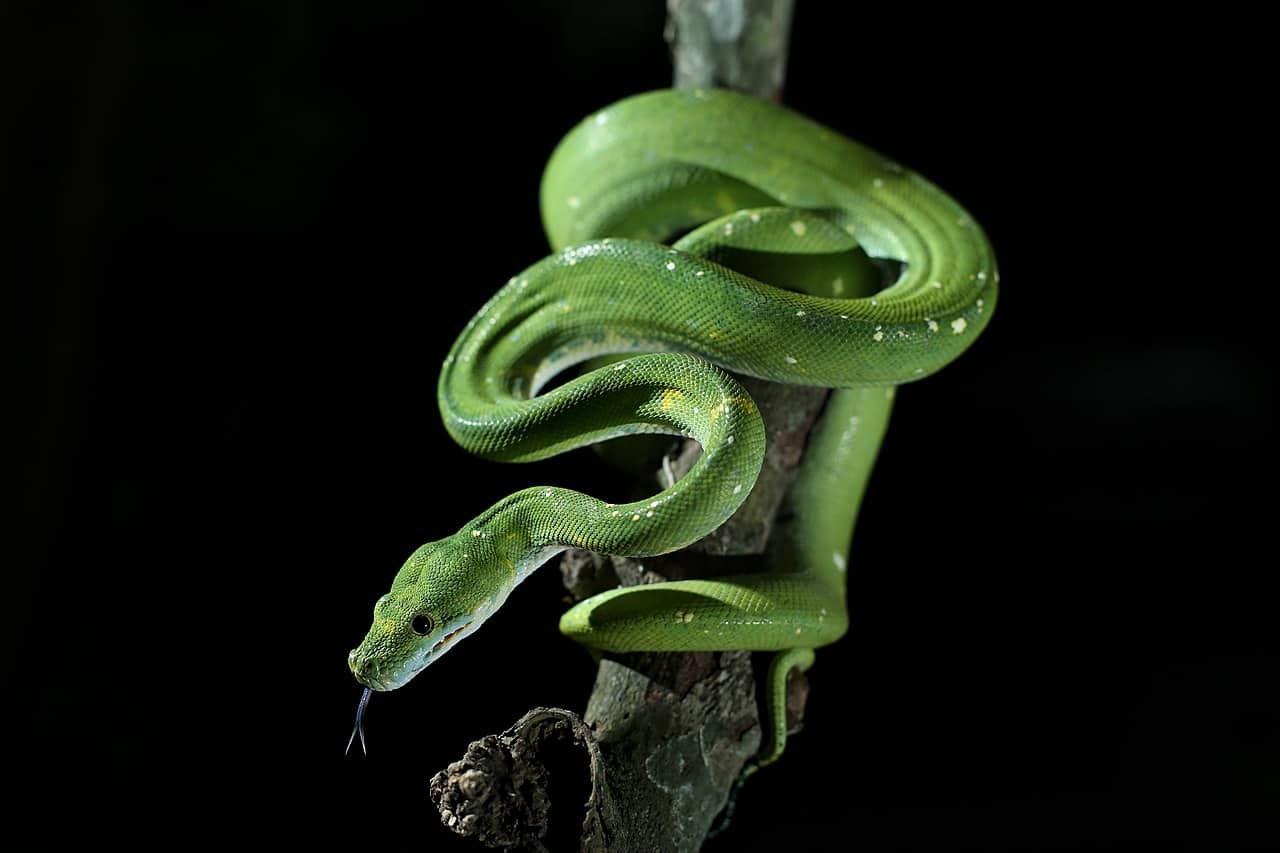
A double-sided snake coin. On the international reptile market, the green tree python is easily confused. It’s a bizarre clone of the emerald tree boa, which lives over 5000 miles away, yet has somehow converged into the same fine-tuned morph. In a pet shop, only an expert could tell what he’s looking at. But in Australia, identifying a green tree python is extremely easy, as there’s no other native snake that looks like them.
Australia has a lack of juicy green snakes; the green tree snake (Dendrelaphis augusticeps) is a contender, but is far thinner, and lives near civilised Sydney. Green tree pythons are a bulky brute and live only in Queensland rainforests, particularly notophyll vine forest fragments. This species is purely green except for thin white markings. Their skull is primitive and bulky, and they spend most of the day coiled on branches, in ambush posture.
If you’ve arrived in humid Queensland after the long drive north, with your trusty camera, there’s no way you could misidentify this snake. Green tree pythons are easy to examine, as they stay calm even when approached to a few feet. Their eyes are yellow, and their pupils sharply vertical. A carpet python subspecies also lives in these jungles, but this is yellow and black.
| 9 | Karoo tiger snake |
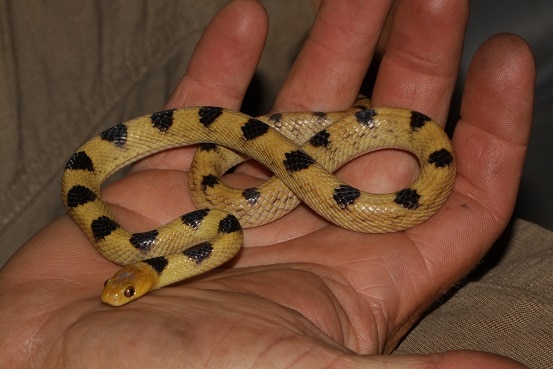
A small snake of southern Namibia and areas directly over the border in South Africa. Karoo tiger snakes inhabit dry, rocky areas, and can be spotted resting on large rock slabs. While harmless, they perform an aggressive intimidation display, hissing loudly and gaping their mouth wide open.
Karoo tiger snakes are easily separable from cobras, adders, skaapstekers and other serpent neighbours. They have clean, sandy scales adorned with simple black blotches, with no complex markings inbetween. They almost look like a children’s toy, which might produce a sound effect if you shake it, which gets weaker and more muffled over the months until the battery dies.
Karoo tiger snakes have bulging eyes, which are sometimes nearly red. Their closest relative is the western tiger snake, which has straight, thinner black markings, but these barely overlap. In the southern half of Namibia, no other snake resembles Telescopus beetzi. They can be tricky to find, lurking in crevices between jumbled rocks, but they’re simple to identify. While the black blotches grow smaller lower down, the colours are identical from head to tail. This harmless species has no relation to Australia’s tiger snake.
| 10 | Red bamboo snake |
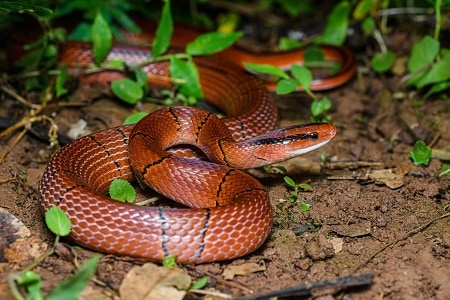
One of the world’s most purely red snakes, and a much dreamed of prize for reptile keepers. The Latin name of Oreocryptophis translates to “secretive mountain snake”, and that’s what this species is. Red bamboo snakes live in northern Thailand and reach a maximum of 100cm, with females being longer. This snake lives in moist but cool forests, where it lurks under leaves and rotting logs all day. They’re hard to find, but their redness is a dead giveaway if you do.
Red bamboo snakes have a black line on their skull, and another pair extending from each eye. At the body, these switch to thin, horizontal bands, with the segments between having slightly different red shades, sometimes orange tinted. Thailand is a kaleidoscope of snakes, but somehow none match the pure redness of this species. That’s before you learn the specific markings, which make you virtually unstoppable.
Red bamboo snakes are traded on the international reptile market, but not abundantly. Many forum threads have been devoted to their regal styles. They look somewhat like an emperor’s palace guard, standing watch at the door. The red bamboo snake’s diet isn’t fully researched, but in captivity, they swallow mice with aplomb.
